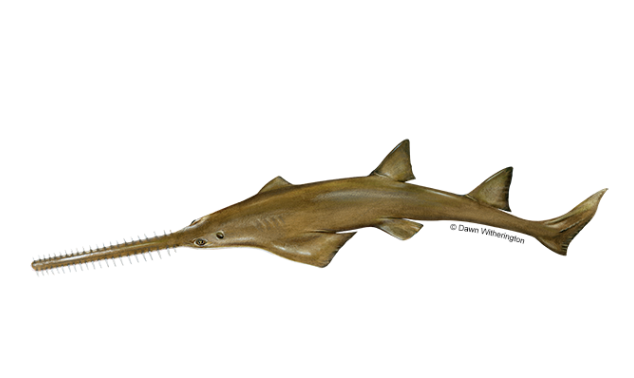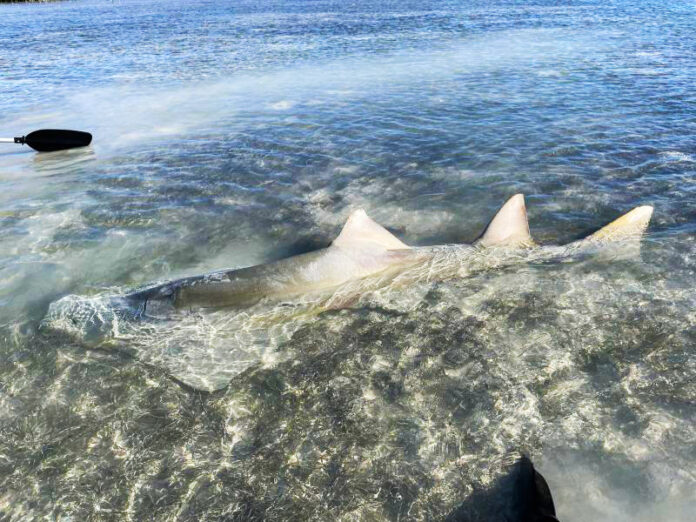Unexplained deaths of the already endangered sawfish. Various fish species swimming upside down in circles. A dead sawfish found missing its rostrum, more commonly known as its namesake saw.
The Florida Keys, famous for world-class fishing and breathtaking water views, now have unusually troubled waters and a mystery to solve.
Since November 2023, 17 smalltooth sawfish have turned up dead in the Lower Keys, with seven or so found in the last two months, according to the Florida Fish and Wildlife Conservation Commission.
About 100 reports of abnormal behavior in fish species, from sawfish to mutton snapper, have been logged, FWC Officer Liam Rodriguez told Keys Weekly on Feb. 27.
“All the marine institutes are working together to see if they can figure it out,” Rodriguez said. “Right now, there’s no cause of death.”
No virus, parasites or organ abnormalities were found in fish samples that were examined, according to the Bonefish and Tarpon Trust (BTT). No red tide was found in water samples, and the Florida Department of Environmental Protection did not detect common contaminants.
The toxin behind ciguatera has been found in some water samples taken from where the abnormal behavior occurred, Rodriguez said.
But that’s the most common marine toxin disease worldwide, particularly in Florida and the Caribbean. Ciguatera causes fish poisoning in humans and is why people are warned against eating certain fish, like barracuda.
Researchers continue to collect clues about this problematic Keys fish case.
FWC has a special sawfish hotline for people to report sawfish problems: 1-844-472-9374, and also the email address sawfish@myfwc.com.
People have posted videos on social media showing sawfish struggling in the water. Some have called FWC for help. That’s all they can do when it comes to endangered sawfish, Rodriguez said.
“The best thing they can do is call the hotline and let us know,” Rodriguez said. “We’ll come over and we’ll contact our biologists, our researchers and let them know what the behavior is.”
FWC asks people not to interact with sawfish.
“Sometimes if you try to do good, you’ll probably do harm,” Rodriguez said.
“Even those of us in law enforcement, we don’t come in and grab the fish. First thing we do is contact the biologist and tell them, ‘This is what we have.’ They tell us what to do and what not to do.”

‘Spinning’ fish reported
While sawfish have been found in peril, fishing guides have also reported seeing a host of other species swimming upside down in repeated circles, a behavior commonly called “the spins.”
Since Nov. 7, 2023, 57 reports of fish in distress have come into the BTT and the Lower Keys Guides Association (LKGA).
The spinning behavior happens when fish lose equilibrium, many times after a stressful incident, according to a statement BTT posted online on Feb. 23.
From November 2023 to now, fish stuck in the spins have been consistently spotted, more often at night. The behavior has appeared in 25 species, including tarpon, permit, snook, pinfish, ballyhoo, yellow jack, blue runner, mutton snapper and mangrove snapper.
About 77% of the reports happened between Bogie Channel and Bow Channel in the Lower Keys. Recently, spinning fish reports are coming from west of Bow Channel and Key West. Three reports of the same behavior were reported off Miami, north of Biscayne National Park.
A team of researchers from Florida International University, the University of South Alabama, Florida Gulf Coast University, DEP and FWC began a study in January to find out what’s behind the sawfish deaths and the spinning fish.
Having ruled out red tide and parasites, the study so far hasn’t determined a cause for the deaths or abnormal fish behavior.
But they have discussed findings of a microalgae called gambierdiscus, which produces the toxin that results in ciguatera poisoning in humans.
“At this time, it is unknown whether the co-occurrence of symptomatic fish and elevated concentrations of gambierdiscus are resulting in these fish exhibiting symptoms,” BTT said.
“It is also unknown if this variant of gambierdiscus is producing cytotoxin that moves up the food web, produces any toxin, or produces a toxin that only affects fish through gill absorption.”
Feds investigate mutilated sawfish
On Jan. 31, federal wildlife officers responded to reports of an unhealthy-looking sawfish that was struggling to swim and then beached itself on a sandbar.
When officers found the sawfish, on a shallow flat oceanside of Geiger Key, the fish was missing its saw-shaped snout, or rostrum.
“We’re not sure if the rostrum was removed before or after the sawfish died, but since it’s an endangered species it’s illegal regardless,” NOAA Fisheries said in a post on X (formerly Twitter).
In a statement posted Feb. 22, NOAA Fisheries officials said they believe the rostrum was removed between the evening of Jan. 30 and the following morning.
NOAA’s Office of Law Enforcement said on Feb. 22 it’s offering a reward of up to $20,000 for information that leads to a criminal conviction or a civil penalty of whoever injured or mutilated the sawfish.
The NOAA hotline is 1-800-853-1964. People may remain anonymous but to be eligible for a reward, you must leave your name and contact information.
Smalltooth sawfish are protected under the Endangered Species Act, so it’s illegal to catch, harm, harass or kill one. It’s also illegal to possess, sell or carry sawfish or parts of them – such as the rostrum.





















